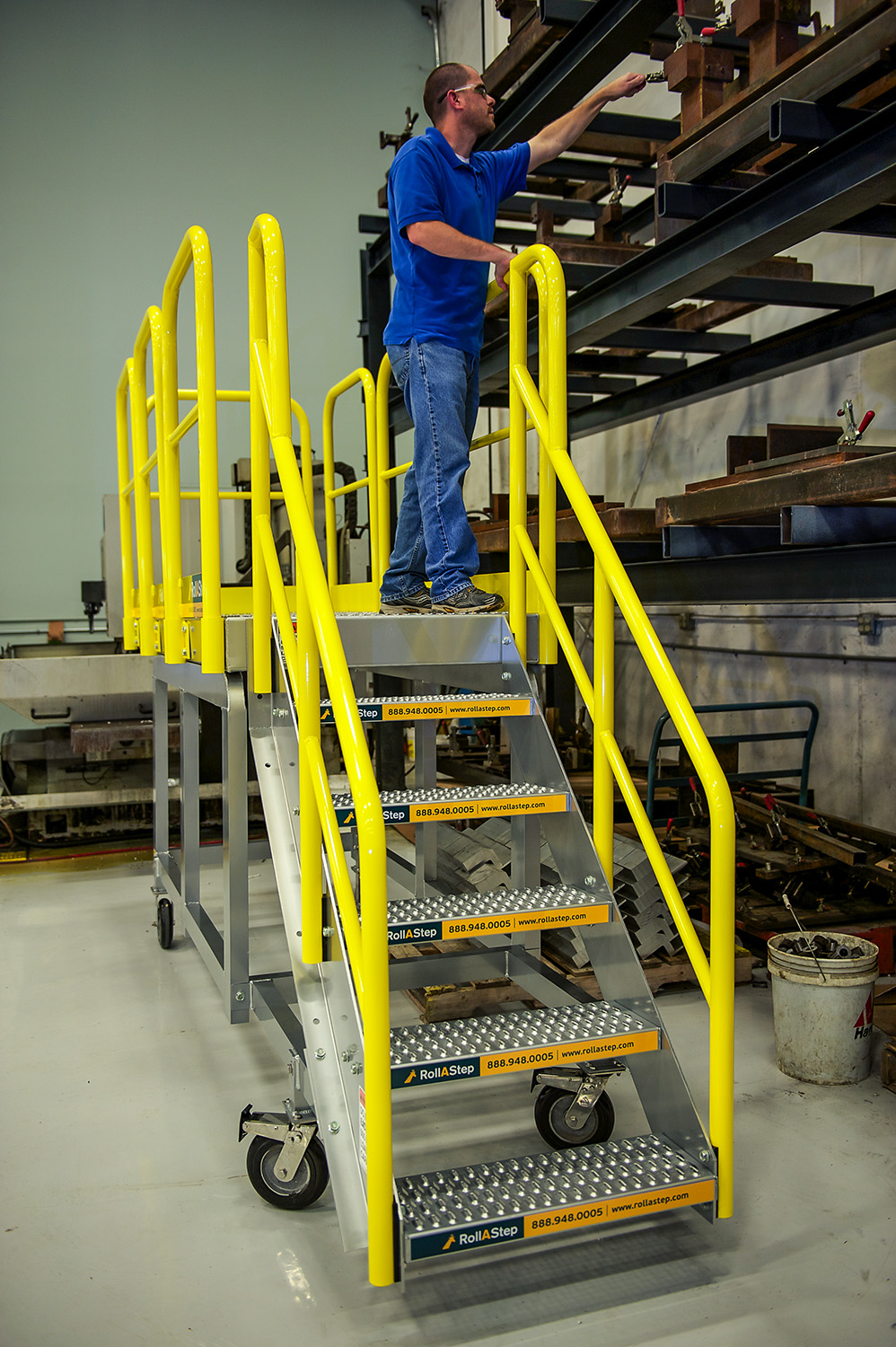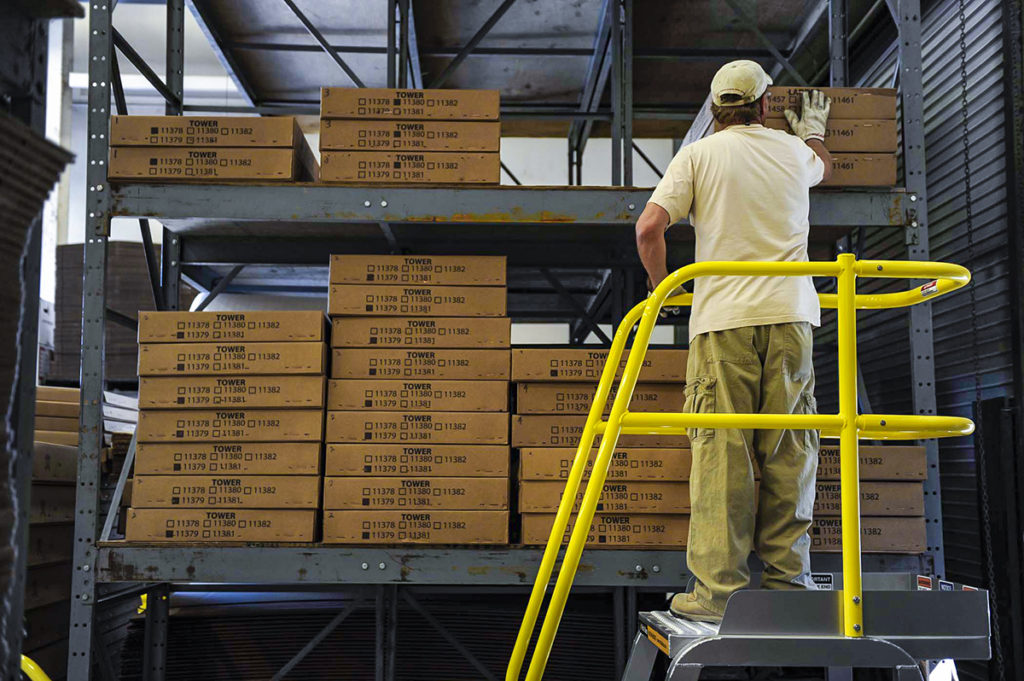Get a quote, configure a custom stair or ask a question. We're here to help!
How Quality Rolling Ladders Will Benefit Your Business
View All Featured InstallationsWorker safety should be a priority for any business. Not only is it the moral thing to do, but it also makes good business sense.
The road to success is paved with good decisions. One must make many investments and purchases as a business owner, but it’s important for them not only to make smart choices in finances. A business owner must protect their workers from harm while in the workplace. The best way for them to do this? Invest in safety equipment that will ensure the well-being of employees while they’re at work!
And we’re not just talking about a basic run-of-the-mill wood ladder here. We mean one made from old scraps of wood! Do you think it’s an easy DIY little side project to assemble a ladder out of wood bits and bobs? Think again because when your workers use this unstable equipment on the job. When you go the cheap route, your workers get hurt. And when that happens, it’s not just their compensation or OSHA fines which are expensive – though those things add up quick too! There could also be litigation ahead depending on what kind of lawsuit arises from this incident.
A lot goes into ensuring safety at work sites, including proper equipment for all employees, so they can complete projects without any accidents happening while using these tools properly and safely.
Portable rolling ladders are tools that many small businesses ultimately invest in as part of their necessary equipment. There are many reasons for this decision, not least because they are considered much safer for use in warehouses and stockrooms than their more standard counterparts. Although there is a place for a traditional ladder, the practicality, useability, and safety of rolling ladders make them the preferred choice for many business owners. And when it comes to choosing a rolling ladder, there are a few key factors that facility managers should consider to find the perfect fit for your business needs. These include things like height, weight capacity, and ease of use. With so many options on the market, it’s important to take the time to find the perfect rolling ladder for your business. But, with a little bit of research, you’ll be sure to find the ideal ladder to help keep your employees safe and productive.
You’re Out in the Front with Mobility at Workers’ Fingertips
As the name implies, rolling ladders have WHEELS allowing to push and pull these from one location to another. In contrast to step ladders and extension ladders, which must be lifted and carried to move around, workers are always ready to roll with the punches.
Rolling ladders come in different sizes and styles, but they all share the common feature of having wheels that make them easy to transport. Some rolling ladders have four wheels, while others have only two. Tilt and roll models with only two wheels are typically moved in a similar fashion to a wheelbarrow, making them easy to maneuver around tight spaces or corners. Rolling ladders are a convenient option for many different tasks, and their portability makes them especially useful in busy work environments.

Cleaning Aluminum Portable Ladders is a Breeze
Rolling ladders are a common sight in industrial environments and warehouses. These ladders often assist workers in reaching high shelves and other hard-to-reach areas. However, grease, oil, and other materials can contaminate portable ladders activating accident-prone scenarios. OSHA Standard 1910.23 clarifies that all ladder forms are covered, including portable ones!
Mobile ladders, including stands and platforms, must be slip-resistant:
Rungs and steps of portable metal ladders are corrugated, knurled, dimpled, coated with skid-resistant material, or otherwise treated to minimize the possibility of slipping.
The steps and platforms of mobile ladder stands and platforms are slip-resistant. Slip-resistant surfaces must be either an integral part of the design and construction of the mobile ladder stand and platform or provided as a secondary process or operation, such as dimpling, knurling, shot blasting, coating, spraying, or applying durable slip-resistant tapes.
Workers must be motivated to clean steps on rolling ladders of all contaminants immediately, and they can do this by using a solvent or steam. Our line of metal stairs, work platforms, and rolling ladders are easy to clean. With modular stair parts constructed with corrosion-resistant aluminum–workers don’t see it as bending over backward to do the job themselves because safety is as easy as wiping it clean! In addition, no worker or cargo should be placed on the ladder’s top step. By following these simple guidelines, workers can help to ensure a safe and productive work environment.
Portability Has Its Downsides
When using a rolling ladder, workers must face the ladder when ascending or descending, and their hands should be free. The ladder should be equipped with a brake or locking mechanism to prevent the wheels or casters from moving when in use. However, this also means they can be rolling when in use, which can be dangerous. Brake and locking mechanisms are standard features preventing accidental and unwanted roll-offs, ensuring that the ladder remains stationary when in use, and causing fall injuries.
Property custodians must also store rolling ladders for easy inspection and service. Keep ladders away from front doors’ opening unless the door is meant to block the entrance or is locked. Ladders shall not be placed in walkways or driveways unless they are protected from traffic; while moving mobile stairs while occupied or in use is a huge no-no. Before using a rolling ladder, workers should inspect it for damage and ensure that all parts are fully functional.
Workers who use rolling ladders should be aware of the potential for hazards. Having wheels that need to swivel around and locking mechanisms, portable ladders are prone to damaged parts. Workers should not use the ladder until a repair is complete and the damaged part is replaced. Once damage occurs, the ladder may no longer roll smoothly, making it more difficult and unstable to use. In addition, rolling ladders are often used in tight spaces, where a small change in trajectory can result in head concussions or broken limbs. For these reasons, workers must inspect their rolling ladders regularly and repair any damage immediately.
The portability of rolling ladders indeed has a price. They are convenient because they can be easily moved when needed. However, they also pose a greater hazard than other ladders due to their wheels. When using a rolling ladder, it is important to be aware of the potential for tipping or slipping. The wheels can also become caught on uneven surfaces, leading to the ladder toppling over.
Quality and Reliable Rolling Ladders Worth the Upfront Cost
Worker safety is one of the most important aspects of any business. Not only is it the right thing to do, but it also makes good business sense. Invested in quality equipment to keep workers safe, you are less likely to experience accidents and worker injury, which can lead to lost time and productivity, worker compensation claims, and increased insurance premiums.
In addition, happy and healthy workers are more likely to be loyal and stay with your company for the long run. While it may seem like a costly investment up front, investing in quality equipment to keep your workers safe is a smart business decision that will pay off in the long run.










